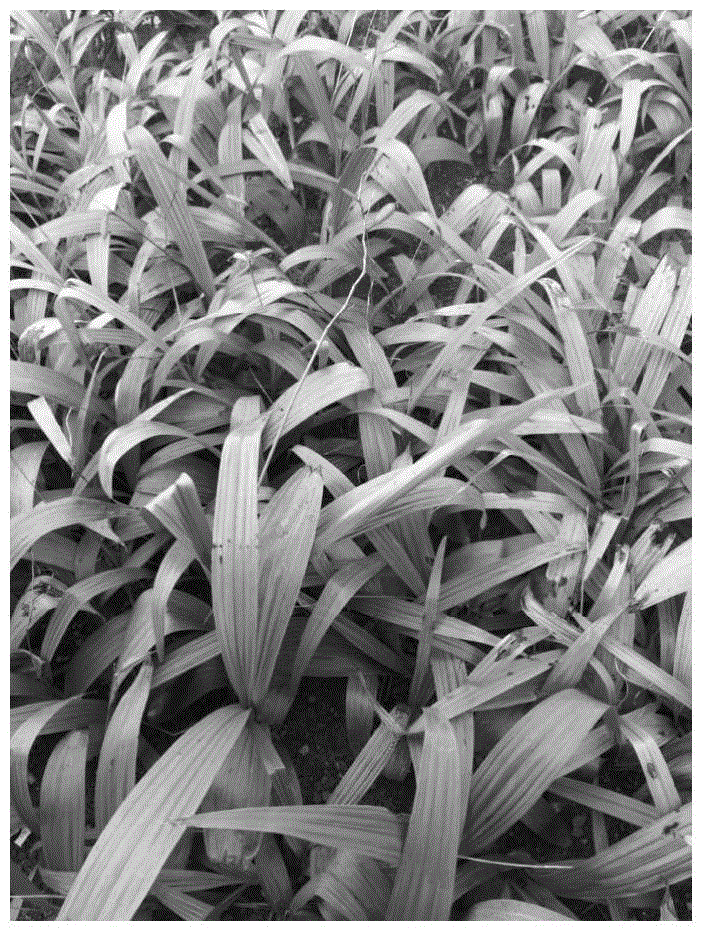Method for planting bletilla striata by using edible fungus residues
A technology of edible fungi and fungus residues, applied in botany equipment and methods, fertilization methods, applications, etc., can solve problems such as poor fertilizer effects, achieve the effects of reducing land rent costs, improving fertility, and reducing pollution
- Summary
- Abstract
- Description
- Claims
- Application Information
AI Technical Summary
Problems solved by technology
Method used
Image
Examples
Embodiment 1
[0034] (1) Site selection: Select pear orchards with well-drained soil, neutral sandy soil, canopy density of 0.5 and relatively regular planting as the planting site.
[0035] (2) Fermentation of edible fungus dregs: put the edible fungus dregs in a cool and ventilated place to dry, after crushing, add 5 kg of urea for every 100 kg of edible fungus dregs, and add a small amount of water to mix well. It will disperse when touched; piled up into a pile, covered with a layer of plastic film for natural fermentation, after fermentation is mature, open the plastic film to let it dry naturally, and set aside.
[0036] 3) Plow the ground to improve the soil: deep plow the soil with a depth of about 35cm. After about a week of exposure to the sun, apply 200kg of fermented edible fungus residue, and then lightly turn it once at a depth of about 11cm to mix the edible fungus residue with the soil. .
[0037] (4) Planting: domesticate the hardened seedlings for about 2 months, transpla...
Embodiment 2
[0043] (1) Site selection: Select pear orchards with well-drained soil, neutral sandy soil, canopy density of 0.5 and relatively regular planting as the planting site.
[0044] (2) Fermentation of edible fungus dregs: put the edible fungus dregs in a cool and ventilated place to dry, after crushing, add 5 kg of urea for every 100 kg of edible fungus dregs, and add a small amount of water to mix well. It will disperse when touched; piled up into a pile, covered with a layer of plastic film for natural fermentation, after fermentation is mature, open the plastic film to let it dry naturally, and set aside.
[0045] 3) Plow the ground to improve the soil: plow the ground deeply to a depth of about 35cm. After about a week of exposure to the sun, apply 250kg of fermented edible fungus residue, and then lightly turn it once to a depth of about 11cm to mix the edible fungus residue with the soil. .
[0046] (4) Planting: domesticate the hardened seedlings for about 2 months, transp...
Embodiment 3
[0052] (1) Site selection: Select pear orchards with well-drained soil, acidic sandy soil with a pH of about 6, canopy density of 0.5 and relatively regular planting as the planting site.
[0053] (2) Fermentation of edible fungus dregs: put the edible fungus dregs in a cool and ventilated place to dry, after crushing, add 5 kg of urea for every 100 kg of edible fungus dregs, and add a small amount of water to mix well. It will disperse when touched; piled up into a pile, covered with a layer of plastic film for natural fermentation, after fermentation is mature, open the plastic film to let it dry naturally, and set aside.
[0054] 3) Plow the ground to improve the soil: deep plow the land with a depth of about 35cm. After about a week of exposure to the sun, apply 300kg of fermented edible fungus residue, and then lightly turn it once at a depth of about 11cm to mix the edible fungus residue with the soil. .
[0055] (4) Planting: domesticate the hardened seedlings for about ...
PUM
| Property | Measurement | Unit |
|---|---|---|
| canopy density | aaaaa | aaaaa |
Abstract
Description
Claims
Application Information
 Login to View More
Login to View More - R&D
- Intellectual Property
- Life Sciences
- Materials
- Tech Scout
- Unparalleled Data Quality
- Higher Quality Content
- 60% Fewer Hallucinations
Browse by: Latest US Patents, China's latest patents, Technical Efficacy Thesaurus, Application Domain, Technology Topic, Popular Technical Reports.
© 2025 PatSnap. All rights reserved.Legal|Privacy policy|Modern Slavery Act Transparency Statement|Sitemap|About US| Contact US: help@patsnap.com


